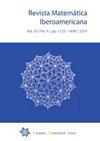A Fubini type theorem for rough integration
IF 1
2区 数学
Q1 MATHEMATICS
引用次数: 0
Abstract
We develop the integration theory of two-parameter controlled paths $Y$ allowing us to define integrals of the form \begin{equation} \int_{[s,t] \times [u,v]} Y_{r,r'} \;d(X_{r}, X_{r'}) \end{equation} where $X$ is the geometric $p$-rough path that controls $Y$. This extends to arbitrary regularity the definition presented for $2\leq p<3$ in the recent paper of Hairer and Gerasimovi\v{c}s where it is used in the proof of a version of H\"{o}rmander's theorem for a class of SPDEs. We extend the Fubini type theorem of the same paper by showing that this two-parameter integral coincides with the two iterated one-parameter integrals \[ \int_{[s,t] \times [u,v]} Y_{r,r'} \;d(X_{r}, X_{r'}) = \int_{s}^{t} \int_{u}^{v} Y_{r,r'} \;dX_{r'} \;dX_{r'} = \int_{u}^{v} \int_{s}^{t} Y_{r,r'} \;dX_{r} \;dX_{r'}. \] A priori these three integrals have distinct definitions, and so this parallels the classical Fubini's theorem for product measures. By extending the two-parameter Young-Towghi inequality in this context, we derive a maximal inequality for the discrete integrals approximating the two-parameter integral. We also extend the analysis to consider integrals of the form \begin{equation*} \int_{[s,t] \times [u,v]} Y_{r,r'} \; d(X_{r}, \tilde{X}_{r'}) \end{equation*} for possibly different rough paths $X$ and $\tilde{X}$, and obtain the corresponding Fubini type theorem. We prove continuity estimates for these integrals in the appropriate rough path topologies. As an application we consider the signature kernel, which has recently emerged as a useful tool in data science, as an example of a two-parameter controlled rough path which also solves a two-parameter rough integral equation.粗糙积分的一个Fubini型定理
我们发展了两参数控制路径$Y$的积分理论,使我们能够定义形式为\ begin{equation}\ int_{[s,t]\times[u,v]}Y_{r,r'}\的积分;d(X_{r},X_{r'})\end{方程},其中$X$是控制$Y$的几何$p$粗略路径。这扩展到了Hairer和Gerasimovi\v最近的论文中对$2\leqp<3$的定义的任意正则性{c}s其中它用于证明H的一个版本“{o}rmander关于一类SPDE的定理。我们推广了同一篇文章的Fubini型定理,证明了这一双参数积分与两个迭代的单参数积分\[\int_{[s,t]\times[u,v]}Y_{r,r'}\重合;d(X_{r},X_{r'})=\int_{s}^{t}\int_{u}^{v}Y_{r,r'}\;dX_{r’}\;dX_{r'}=\int_{u}^{v}\int_{s}^{t}Y_{r,r’}\;dX_{r}\;dX_{r'}.\]先验地,这三个积分有不同的定义,因此这与乘积测度的经典Fubini定理相似。在这种情况下,通过扩展两参数Young-Towghi不等式,我们导出了离散积分逼近两参数积分的最大不等式。我们还将分析扩展到考虑形式为\ begin{equipment*}\ int_{[s,t]\times[u,v]}Y_{r,r'}\的积分;d(X_{r},\tilde{X}_{r’})\end{方程*},并得到相应的Fubini型定理。我们在适当的粗糙路径拓扑中证明了这些积分的连续性估计。作为一种应用,我们将最近在数据科学中成为有用工具的签名内核视为双参数控制粗糙路径的一个例子,该算法还求解了一个双参数粗糙积分方程。
本文章由计算机程序翻译,如有差异,请以英文原文为准。
求助全文
约1分钟内获得全文
求助全文
来源期刊
CiteScore
2.40
自引率
0.00%
发文量
61
审稿时长
>12 weeks
期刊介绍:
Revista Matemática Iberoamericana publishes original research articles on all areas of mathematics. Its distinguished Editorial Board selects papers according to the highest standards. Founded in 1985, Revista is a scientific journal of Real Sociedad Matemática Española.

 求助内容:
求助内容: 应助结果提醒方式:
应助结果提醒方式:


